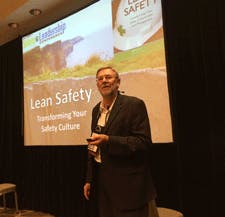When building new facilities or defining new processes, employers can eliminate – or at least minimize – hazards before the work even starts. In reality, though, most EHS professionals are dealing with old facilities and longstanding processes in which risks and hazards already exist.
Similarly, the current culture (how people think, act and interact) of an existing business typically is saddled with people problems and challenges that management has to address daily. A common solution to both risk reduction and cultural re-direction is a new management philosophy grounded in the dual beliefs that the customer is first and that each and every employee should be engaged in business improvement. That continuous-improvement philosophy commonly is called “lean.”
Lean Isn't a Program
What is lean? It’s not a program; it’s a philosophy. It’s a way of thinking and seeing the world.
Management teams all over the world want to improve the businesses they manage. Lean provides a structured approach that’s simple to understand but difficult to implement. Difficult to implement because it requires most managers to change their style of leadership while engaging all of their reports in a journey of workplace culture change.
Not many managers have the stomach to lead this rigorous journey, but those who do are unique. They understand that a business must focus on the customer – not profitability. They clearly understand that if you have satisfied customers, profitability will follow.
Lean should be the model for every EHS manager – because managing EHS compliance no longer is good enough.— Robert Hafey
Many businesses still are managed in a hierarchical, top-down directive fashion that relies on layers of managers telling their reports what to do. Traditional compliance-based safety management is a mirror reflection of these directive management practices. It relies on EHS professionals often telling people what to do and policing them to ensure compliance.
Progressive businesses that utilize a lean or continuous-improvement approach to management have come to the realization that a new style of leadership is necessary – a people-centric approach to leadership that requires managers to ask the right questions rather than have the right answers.
Managers must extend trust to others so they return trust. It’s a team-building exercise that develops a workforce focused on customer and continuous improvement because it makes sense to them. It makes sense because management has allowed them to be involved and engaged in business improvement. They go home at the end of their workday feeling as if they’ve made a difference. They feel empowered.
Leveraging Lean
How can EHS professionals take advantage of and support this type of cultural shift in a business?
Armed with this new understanding, they now can focus on the continuous improvement of the EHS processes they manage. In addition, they can take advantage of the new switched-on workforce by engaging them in EHS improvement activities.
Most of the lean tools used to drive cycle-time reduction from business processes also can be used to drive continuous-improvement safety. Some examples are safety kaizen blitzes and safety gemba walks.
Kaizen Blitzes
A traditional kaizen blitz is a structured, clearly defined, multi-day, rapid continuous-improvement activity that engages a cross-functional team in the pursuit of cycle-time gains. EHS professionals can use that same structured framework to challenge a team of hourly workers to reduce the risk of soft-tissue injuries or their exposure to hazards.
By facilitating safety kaizen events, an EHS professional can engage and empower those who do the work to make a safety difference in their own work areas. When this is done effectively, it builds trust and starts to shift the ownership of safety to those who perform the work.
Gemba Walks
Safety gemba walks are educational events intended to help others see and understand continuous-improvement safety. Gemba, a Japanese word, refers to “where the work is done.” Traditional safety walks through a work area focus on non-compliance, while safety gemba walks focus on proactive safety improvement. By simply observing people at work and engaging them in conversations about the body positioning required to perform the work, hazards can be identified and eliminated.
Just as in the kaizen-blitz events, the key to success is the engagement of the workers in the identification and elimination of the hazards. That key understanding is what differentiates lean safety from traditional compliance safety.
How Lean Benefits EHS Professionals
This approach benefits EHS professionals in many ways. Their organizations will view them as even more valuable, because they are:
- Reducing cycle times of business processes by focusing the workforce on safety improvement.
- Building trust between the workforce and management.
- Engaging others in EHS activities.
- Proactively reducing the possibility of injuries.
This is a proactive risk-reduction approach driven by continuous improvement, and it should be the model for every EHS manager – because managing EHS compliance no longer is good enough.
Robert B. Hafey is president of RBH Consulting LLC and author of “Lean Safety” and “Lean Safety Gemba Walks.”

